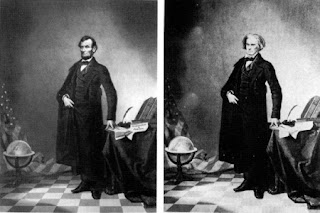Photo Manipulation and Ethics the
A. Media management is big on manipulating photos. Manipulating a photo is used in order to make the photo more appealing, without changing the photo too much. However, there is a lot of controversy over whether it is ethical or not. Many people believe that manipulating photos is going against the morals and values of people. While others argue that making a photo more appealing for the public isn't a bad thing. It becomes an issue of ethics vs aesthetics. Advanced technology allows everyone to have access to manipulating and editing photos. The more we photoshop, the less people will believe that what they see on newspapers, magazines, and other organizations is accurate.
B. The philosophy of newspapers such as Washington Post and the New York times is that they have very strict guidelines over photo manipulation. Simple color change or image scaling is considered unethical to them. They believe that it is important for all photojournalists to report what they see as they see it. This is managed by, when the journalists turn in there work they make sure they have there original copy. This allows them to know that nothing has been altered or change to there photos.
C. I think that certain things are acceptable to do when manipulating a photo. However, there also are many limits on what you can do. It is okay to change the brightness or tone of a photograph in order to enhance and make the quality of the image look better. I think it's okay to change the small things. For example if one eye is more squinted there the other eye, it's okay to photoshop them to look the same. However, that doesn't mean you can edit the whole person. As long as someone is keeping there looks and not edited to change there body or major physical features, then it is okay. If someone is completely altered to the point where it doesn't even look like them anymore, than that is unethical. Overall, if you are keeping the picture as a whole and only adjusting small things to make the photo a little more appealing, than that is ethical.

D. I think this photo is the most unethical because the manipulated photo appears to be a completely different person. They took an iconic photo of Abraham Lincoln and changed it to be a mix of Lincoln and the Southern politician, John Calhoun. This is unethical because they altered the photo to be a completely different person. If you saw this photo you wouldn't be able to recognize that this was a photograph of Lincoln. This means that it was manipulated to a point where you don't even know what the true photo looked like. If you cannot recognize the original image then that is very unethical.

E. I consider this photo the least unethical because you can still tell that this is the same person. The only thing that was altered was the brightness and tone of the photograph. That is just simple editing to make the quality of the image better and easier to see. Therefore, I think it's ethical because you can still tell when looking at the images side by side that it is the same man, and his physical features remained the same.
B. The philosophy of newspapers such as Washington Post and the New York times is that they have very strict guidelines over photo manipulation. Simple color change or image scaling is considered unethical to them. They believe that it is important for all photojournalists to report what they see as they see it. This is managed by, when the journalists turn in there work they make sure they have there original copy. This allows them to know that nothing has been altered or change to there photos.
C. I think that certain things are acceptable to do when manipulating a photo. However, there also are many limits on what you can do. It is okay to change the brightness or tone of a photograph in order to enhance and make the quality of the image look better. I think it's okay to change the small things. For example if one eye is more squinted there the other eye, it's okay to photoshop them to look the same. However, that doesn't mean you can edit the whole person. As long as someone is keeping there looks and not edited to change there body or major physical features, then it is okay. If someone is completely altered to the point where it doesn't even look like them anymore, than that is unethical. Overall, if you are keeping the picture as a whole and only adjusting small things to make the photo a little more appealing, than that is ethical.

D. I think this photo is the most unethical because the manipulated photo appears to be a completely different person. They took an iconic photo of Abraham Lincoln and changed it to be a mix of Lincoln and the Southern politician, John Calhoun. This is unethical because they altered the photo to be a completely different person. If you saw this photo you wouldn't be able to recognize that this was a photograph of Lincoln. This means that it was manipulated to a point where you don't even know what the true photo looked like. If you cannot recognize the original image then that is very unethical.

E. I consider this photo the least unethical because you can still tell that this is the same person. The only thing that was altered was the brightness and tone of the photograph. That is just simple editing to make the quality of the image better and easier to see. Therefore, I think it's ethical because you can still tell when looking at the images side by side that it is the same man, and his physical features remained the same.


Comments
Post a Comment